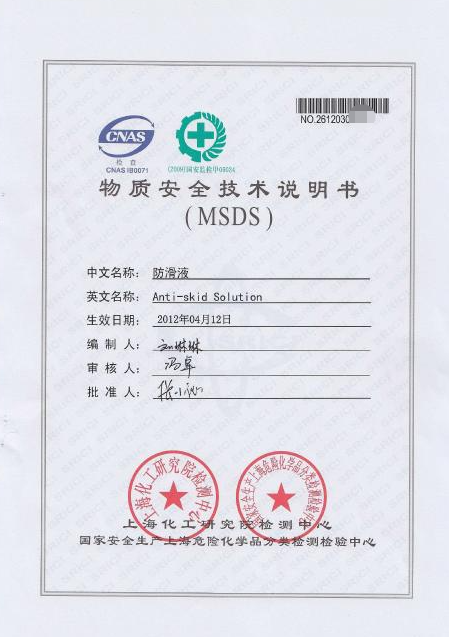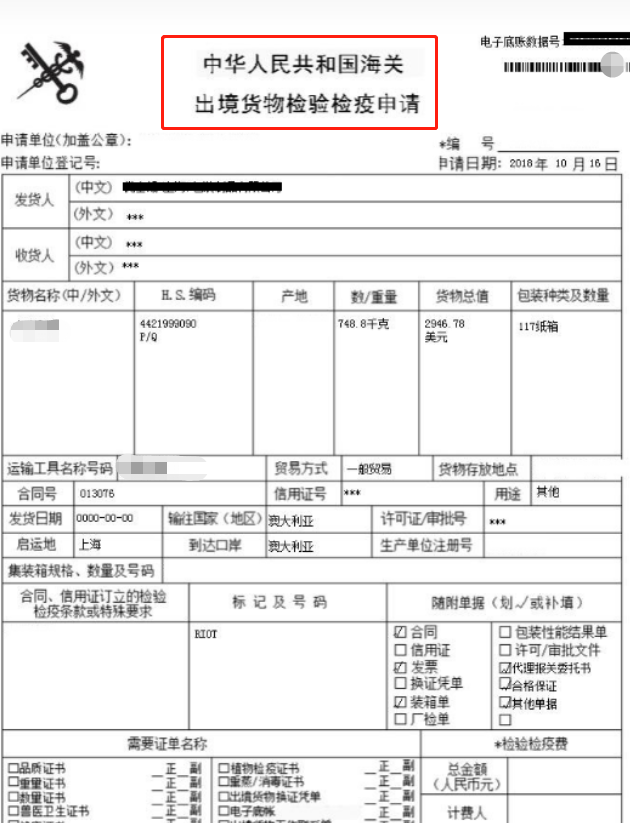Be your Logistics Department in China
Customized logistics solutions, your logistics expert in China
Customized logistics solutions, Shipping from China to the World
Tel:+8613424475220 Email:info@viputrans.com 
Required documents for export of dangerous goods
Dangerous goods are divided into 9 categories:
Class I: explosives (ignoring 1.4 fireworks);
Class II: compressed gas;
Class III: Flammable liquids;
Class IV: flammable solids, flammable articles and wet flammable articles;
Class V: Oxidizing agents and organic oxides;
Class VI: poisonous and infectious substances;
Class VII: radioactivity (neglect);
Class VIII: corrosive;
Class IX:Miscellaneous.
But if you want to export chemicals from China, you need at least the following documents, let's see what they are:
*.MSDS-MSDS (Material Safety Data Sheet)
MSDS (Material Safety Data Sheet) is the Chemical Safety Data Sheet. It can also be translated as Chemical Safety Data Sheet or Chemical Safety Data Sheet. Chemical products will have MSDS. In European countries, MSDS is also called SDS. It is used by chemical manufacturers and importers to clarify the physical and chemical characteristics of chemicals (such as pH value, flash point, flammability, reactivity, etc.) and the impact on users. A file of possible hazards to health (such as carcinogenicity, teratogenicity, etc.), with a total of 16 items.
1. Chemical Product and Company Identification (Chemical Product and Company Identification): It mainly indicates the name of the chemical, the name of the manufacturer, address, zip code, telephone number, emergency telephone number, fax and e-mail address and other information.
2. Information on Hazardous Ingredients: Indicate whether the chemical is a pure chemical or a mixture, including all harmful substances exceeding 1%, and all carcinogenic substances exceeding 0.1%. For pure chemicals, their chemical name or trade name and common name should be given. For mixtures, the concentration or concentration range of the hazardous components should be given. Regardless of whether it is a pure chemical or a mixture, if it contains hazardous components, it should be given a chemical abstract index registration number (CAS number).
3. Hazard identification: an overview of the most important hazards and impacts on health of the chemical, mainly including: hazard category, invasion route, health hazard, environmental hazard, explosion hazard and other information.
4. First Aid Measures: self-rescue or mutual rescue measures (inhalation, ingestion, eye contact, skin contact treatment) in case of accidental injury.
5. Fire Fighting Measures: It mainly indicates the physical and chemical special hazards of chemicals, suitable fire extinguishing media, unsuitable fire extinguishing media and personal protection of firefighters, including: Hazardous characteristics, fire extinguishing media and methods , Precautions for fire fighting, etc.
6. Accidental Release Measures: Procedures for cleaning up small and large spills, as specified in CITES and surrounding chemical spills.
7. Handling and Storage: Provide safe storage of relevant materials and safe use of relevant materials.
8. Exposure Control/Personal Protection: During the production, handling, handling and use of chemicals, the protective methods and means adopted to protect workers from chemical hazards, including gloves , clothing, eye protection, respiratory protection.
9. Physical and Chemical Properties: mainly describe the appearance and physical and chemical properties of chemicals, including: appearance and properties, ph value, boiling point, melting point, relative density (water=1), relative vapor density (air=1), saturated vapor pressure, heat of combustion, critical temperature, critical pressure, octanol/water partition coefficient, flash point, ignition temperature, explosion limit, solubility, main uses and some other special physical and chemical properties.
10. Stability and Reactivity: Indicates stable substances, what causes instability and incompatibility. Including: Stability, incompatibilities, conditions to avoid, polymerization hazards, decomposition products.
11. Toxicology Information: Provide toxicological information of chemicals, including: acute toxicity (LD50, LD50), irritation, sensitization, subacute and chronic toxicity, mutagenicity, Teratogenicity, carcinogenicity, etc.
12. Ecological Information: mainly states the environmental ecological effects, behaviors and outcomes of chemicals, including: biological effects (such as LD50, LD50), biodegradability, bioaccumulation, environmental migration and other harmful environmental effects impact etc.
13. Disposal Considerations: Refers to the safe disposal methods for chemical-contaminated packaging and useless chemicals, including disposal methods and precautions.
14. Transportation Information: mainly refers to domestic and international chemical packaging, transportation requirements and classification and numbering of transportation regulations, including: dangerous goods number, packaging category, packaging mark, packaging method, UN number and transportation Precautions, etc.
15. Regulatory Information: mainly legal provisions and standards on chemical management. EPA and OSHA regulations related to CITES.
16. Other Information: It mainly provides other information that is important to safety, including: references, time for filling in the form, department for filling out the form, data review unit, et
Generally speaking, MSDS is used to judge whether it is suitable for sea transportation and what appropriate method to use to ensure the safety of transportation and when booking space for specific cargo exports, the carrier (shipping company) will require MSDS, all contacts or possible contacts Anyone who arrives at the goods (including loading and unloading people, station/warehouse personnel, etc.) needs MSDS. Operators must make correct operations and disposals according to the guidelines and instructions of MSDS, especially in emergency situations such as package damage and leakage. Without MSDS, it will be difficult to find out the situation and delay rescue. Blind action will lead to serious consequences .
The 16 items of MSDS issued by authoritative organizations are very accurate, and Shanghai Institute of Chemical Technology can do it. But now basically the MSDS compiled by the manufacturers themselves is inaccurate, so in many cases, it is necessary to refer to the identification certificate to judge whether it is general goods or dangerous goods.
Report template reference:

Dangerous package certificate:
Dangerous package certificate: the performance inspection result sheet of entry-exit goods packaging, referred to as "dangerous package certificate". When it comes to dangerous goods, we have to talk about the dangerous package certificate.
There are two main aspects of the dangerous package certificate: performance certificate and use certificate. The performance certificate is very simple, and the regular manufacturers that provide packaging can generally issue it.
However, the use certificate is more complicated. It is necessary to use the performance certificate to apply for the local commodity inspection bureau of the factory that produces dangerous goods.
The certificate of use can only be obtained after the commodity inspection bureau inspects the products in this package to be qualified.
It is more troublesome to apply for a use certificate, and the regulations of the commodity inspection bureaus in various places are different, and the details depend on the local commodity inspection bureaus.
It is necessary to go to the local commodity inspection bureau of the factory for consultation and approval. We are still very familiar with Shanghai Commodity Inspection Bureau, the information required for dangerous packages: packaging performance list, classification identification report.
The classification and appraisal report is relatively simple, and the Commodity Inspection Bureau can make it in three days if the sample is provided.
What is really needed for export is the certificate of use of dangerous goods. There is one more procedure for export declaration of dangerous goods than general goods, that is, the declaration of port supervision, and the declaration of port supervision requires the certificate of dangerous goods. If there is no dangerous goods certificate, the cabinet will be closed. No boat.
The Dangerous Package Certificate is specially used for the export of dangerous goods. It is mainly used for products that require dangerous goods packaging for export, such as: toner, nail polish, epoxy glue for cosmetics, perfume, electric hair water, spray, lithium batteries, lighters, etc.
Documents required for the dangerous package certificate:
1. The record book of import and export related dangerous goods;
2. The inspection report;
3. The product transportation condition appraisal report;
4. MSDS (safety technology/data sheet);
5. Product packaging performance inspection result sheet ;
6. At the same time, it is necessary to provide several samples of related dangerous goods;
7. There are also several samples of packaging.
UN, CLASS, PG, product name, valid date, and number of pieces in the dangerous package certificate. These are more important. Generally, the original dangerous package certificate is issued within a week. The scanned copy is provided when booking the space with the shipping company, and the original is required when making the dangerous declaration.
In addition, some special goods do not have dangerous packages, but other documents can be used instead.
For example, for products packed in steel cylinders, the pot inspection certificate can be used instead of the dangerous package certificate; for products packed in limited cartons, the dangerous package certificate can be replaced by limited quantity certificates; for products packed in tonnage barrels, the ship’s classification certificate can be used Instead of dangerous package certificate, etc.
The export of dangerous goods must have a dangerous package certificate.
Report template reference:

Commodity inspection customs clearance form
Commodity inspection customs clearance form is when foreign trade enterprises need commodity inspection, they go to the Commodity Inspection Bureau to make a commodity inspection customs clearance form.
It is the inspection of commodities, including the inspection of the quality, specifications, quantity, weight, packaging and whether they meet the requirements of safety and sanitation.
In international trade, not all foreign trade companies need to do commodity inspection and customs clearance. The state stipulates that important import and export commodities are not allowed to be imported or exported unless they have been inspected and issued with certificates.
So what kind of products need commodity inspection, commodity inspection process, handling and chemical commodity inspection need to pay attention.
First of all, all exported goods have corresponding HS codes, and the declaration elements and customs supervision conditions can be found with HS codes.
If the regulatory condition is B, it means that export commodity inspection is required. (It is important to note here that if there are no regulatory conditions, but the goods are in the 2015 Hazardous Chemicals Catalog, commodity inspection is also required, as long as one condition is met, commodity inspection is required)
Commodity inspection is the goods that need commodity inspection. You need to go to the local commodity inspection bureau to handle the commodity inspection form.
There is a customs clearance number on the commodity inspection form. Now you can do commodity inspection in different places.
What information is required for the customs clearance form at the Commodity Inspection Bureau? A set of customs declaration documents, customs declaration form, packing list, invoice contract, etc., and then the label and photo of the goods.
At this time, it is necessary to distinguish whether it is general goods or dangerous goods, and the ordinary labels of general goods are enough. For dangerous goods, you need to apply for a dangerous package certificate first.
After the Hazardous Package Certificate is completed, you need to provide the GHS label (Globally Harmonized System of Classification and Labeling of Chemicals) when you go to do the commodity inspection of dangerous goods.
my country's import and export commodity inspection work mainly includes four links: acceptance of inspection, sampling, inspection and issuance of certificates.
Only after passing the inspection and issuing a certificate or a release note can they be shipped. All in all, not all foreign trade enterprises need commodity inspection and customs clearance forms. For those who do not need to do commodity inspections, there is no problem involving commodity inspection and customs clearance forms.
Report template reference:

If you are interested in exporting dangerous goods, you can always consult us.
Shawn.Liao(Mr.) ,E-MAIL:sales04@viputrans.com ;Phone/Wechat:+8618926970495;Whatsapp/Skype: +8613431563558
WCA Member ID No.129936
Copyright © 2003-2025 VIPU Supply Chain Logistics Co., Ltd. | All Rights Reserved
LOGISTICS | E-COMMERCIAL FULFILLMENT | ABOUT US | CASE | NEWS | VIDEO | CONTACT US
We will find the fastest or the cheapest way for your shipment. Please specify: where from, where to, what to ship.